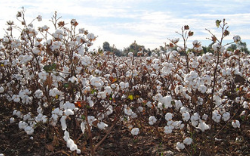The cotton industry in the United States, led by trade groups like National Cotton Council of America, Cotton USA, and Cotton Incorporated, is implementing a 10-year sustainability plan with support across the supply chain from producers, ginners, warehousers, merchants, cottonseed crushers, cooperatives, and manufacturers like Barnhardt.
Producers and other industry organizations have joined forces to set new environmental sustainability targets to push forward the successful efforts of the last generation, so that the US continues to lead the world in producing cotton in responsible ways. The trio of organizations used science-based evaluations to establish target areas and goals for the new sustainability program, including the implementation of key performance indicators (KPIs) for each pound of cotton produced, along with its production pathways.
Here are the goals for the US cotton industry’s 10-year sustainability plan.
Reduce Soil Carbon by 30 Percent
Soil carbon is an indicator of the health of the soil, and the industry has set a goal of reducing this measure by 30 percent, creating more regenerative fields in the process. Practices that reduce soil carbon, such as the planting of cover crops and reduced tillage, also work to reduce atmospheric greenhouse gas.
As part of the plan, the industry is looking to producers to adopt winter cover crops, no-till, and strip-till methods in greater numbers than the current level of 45 percent of the producer population. Benefits to farmers go hand-in-hand with the environmental yields, as producers can expect to see increased crop yields; reduced water use; increased nutrient uptake; reduced fertilizer use; reduced nutrient runoff; and reduced soil loss.
Increase Land Use Efficiency by 13 Percent
With a growing global population requiring more food production every day, it’s more important than ever for the cotton industry to be as efficient as possible with land use. When you increase yields through better genetic varieties and new methods of field management, the possibilities for maximum efficiency come into clearer focus.
To achieve a 10-year goal for land use efficiency improvement by 13 percent, growers must reduce the amount of water per pound of cotton, especially with innovations in water delivery systems; improve soil health with crop rotation, cover cropping, and tilling practices, use precision agriculture technology and techniques, and preserve low insect-, weed-, and disease-related yield loss that U.S. growers currently experience.
Decrease Greenhouse Gas Emissions by 39 Percent
The industry has set an aggressive goal to reduce greenhouse gas emissions by nearly 40 percent in the next 10 years. While cotton naturally removes CO2 from the environment as it grows through photosynthesis, synthetic nitrogen fertilizers account for a great deal of the industry’s adverse effect on the environment, as nitrogen releases into the air in the form of nitrous oxide.
To meet this goal, the cotton industry in the US is working with the scientific community to reduce the amount of nitrogen needed to grow cotton on a per pound basis. Precision agriculture is also key, as implementation of sophisticated field management software can limit the amount of nitrogen fertilizer to the precise amounts needed in different sectors of the field.
Decrease Soil Loss by 50 Percent
Water and wind erosion are the enemies of all farmers, both in terms of yields, efficiency, and sustainability. The industry has set another aggressive goal of reducing soil loss by 50 percent.
Methods already adopted for reducing soil loss include conservation tillage practices and the development of new plant varieties that are tolerant of broad-spectrum foliar herbicides. The recent rise of cover crop adoption has also helped the industry make great strides in preserving usable soil via weed control and reduction of carbon.
Decrease Water Use by 18 Percent
Getting more efficient in water use will allow the industry to grow more cotton with less water, thus reducing costs and use of a key natural resource.
In order to achieve the industry goal of reducing water use by 18 percent, growers must continue to implement, in greater numbers, new innovations in water delivery systems, including Pipe Planner®, laser leveling, low nozzle center pivots and drip irrigation) as well as improved irrigation scheduling tools run via software and soil sensors, another hallmark of precision agriculture technology in the field.
Decrease Energy Use by 15 Percent
While many of the goals rely on the producers to lead the way, decreasing energy use by 15 percent is more reliant upon manufacturers of nitrogen fertilizer, as well as ginners, while producers have responsibility for energy expended during harvest and tillage times.
Reducing tillage and nitrogen applications (via precision agriculture implementation) has reduced the amount of nitrogen required per pound, dropping the energy footprint over the last generation. The industry anticipates robotic technologies will make an impact, as well as gene editing that results in cotton varieties that require lower gin energy costs.
Conclusions
At Barnhardt, we applaud the US cotton industry and all of its constituent groups along the supply chain to lead the agriculture community in sustainability efforts. These six goals, while quite aggressive, may yet be reached due to innovations like the Fieldprint® Calculator. The organizations included a seventh goal of enrolling 2.5 million acres with the calculator, which will measure industry progress toward KPIs related to each goal.
Through leadership, innovation, and doing the hard work necessary, we will achieve these goals together.
